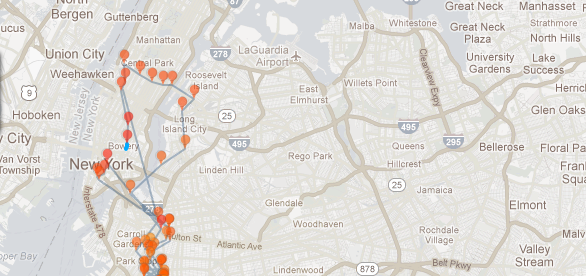Normally when we think of data a series of “0s” and “1s” come to mind, or perhaps the twelve digits of an IP address come to mind. Let’s face it, when we normally think of data it’s normally viewed as a series of cold, hard facts. Jer Thorp wants us to change that.
Yesterday, data artist in residence at The New York Times, Jer Thorp, gave a speech for TedX, independently organized Ted events, urging us to try and humanize our view of data. Among the projects Jer displays are All The Names, and Project Cascade, a New York Times initiative to help visualize the social interactions that occur (particularly sharing) that occurs on the web. He also shows off a beautiful visualization of 11,000 “good morning” tweets. What I found to be the most interesting project he talked about was Open Paths. Jer points out that each day we as humans are creating tons of research gold, whether we’re aware of it or not. You see most of us have some sort of smart phone and Jer helped create a tool that allows iPhone users to upload their location data for research – Open Paths. This is a pretty cool project. It creates a bond between the volunteer and the researcher who uses that individual’s data but more interesting it humanizes that data. It’s no longer “0s” and “1s”, its now part of someone’s history.
What does humanizing data really do? We all know where we liveand work, so what’s the insight? Well once people partook in Open Paths some interesting thing happened…As people witnessed their lives being recreated by pieces of location data they left behind, it became surprisingly moving. No longer was this data a series of lifeless numbers, instead it became “that moment when I got off the plan to start my new life in New York, the restaurant where I had Thai that first night thinking about this new experience of being in New York, the day I met my girlfriend.” Jer brings up an excellent point, “by placing data in a human context it gains meaning.”
“Because these are our histories…but if we can do this with other data, we can put data into a human context, I think we can change a lot of things. Because it builds automatically empathy for the people involved in these systems. And that, in turn, results in a fundamental respect that I believe is missing in a large part of technology. When we start to deal with issues like privacy, by understanding that these numbers are not just numbers, but instead are attached they are tethered to the real world, they carry weight. By understanding that the dialogue becomes a lot different.”
This has the potential to totally shift the way we view data and issues around it and that is what I find particularly intriguing. In this brave new world of data, I believe that we should try to listen to Jer and attempt to humanize the data we’re collecting because it is someone’s history and we should try not to forget that.

